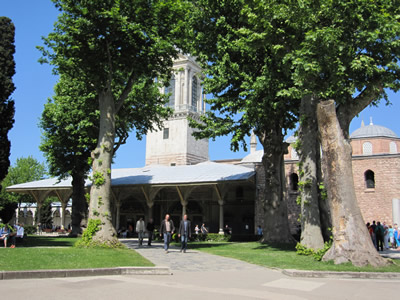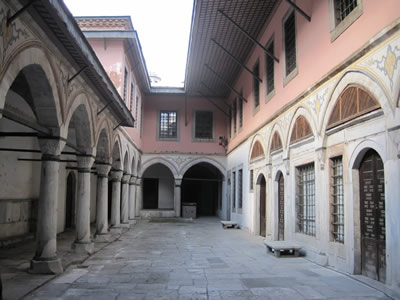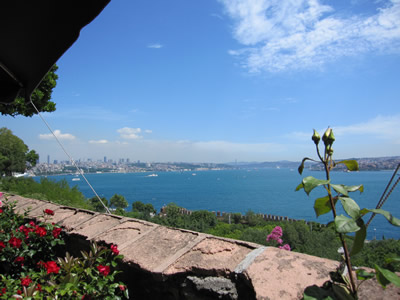
Classic Turkey trip, 2012
ISTANBUL I:
Topkapi;Turkish-Islamic Art Museum; Bosporous
HOME :
turkey trip Istanbul I Istanbul II Istanbul III Istanbul IV Bursa Troy Pergamum Sardes - Pamukkale Aphrodisia Ephesus Priene Didyma MiletCapitels
We arrived in Istanbul in the early afternoon of May 22nd . We found our welcome manand were escorted to the car that was to take us to the hotel, a drive that would take "40 minutes". He said. He lied. After about an hour I nodded off - jet lag was getting to me. I woke up and we were still crawling inch by inch through traffic that didn't seem to advance at all. We saw the old city walls, we saw the Golden Horne, we were told that we had just passed Taksim Square and now we had been crawling for about two hours. another mere fifteen minutes and there really was a hotel at the end of that tunnel! I had bene in Istanbul before, but that was before the city had added about another 4 million people. We did not realize it yet, but that drive was what we would experience again and again throughout the three following days in Istanbul. Let me not badm outh the 405 or 101 or the so-called freeways in Seattle. They ain't nuthin' compared to Istanbul! In the evening we met our tour guide Ayşegül Vaizoglu who insisted we call her Ayşe and who turned out to be delightful as well as knowledgable and competent. We also met the rest of our group and were given an introduction into what the next twelve days would be like. I got my first inkling that this would really be a "Study Trip", no rest for the wicked! The next morning we were on the bus bright and early to get to our first destination: |
||||
| Topkapi Palace The residence of the ottoman rulers from the 15th until the end of the 19th century. Today the palace is a museum and one of the major tourist draws of the city. Ayşe quick-marched us into the third courtyard through the Gate of Felicity. This gate guards the inner sanctum of the palace and no one could enter here without permission of the Sultan (or more probably the guards) Among other important buildings, this court contains the Imperial Treasury and we wanted to get there before the cruiseship tour groups would descend on it. Smart move. Even before the hordes descended it was quite crowded in the treasury, after all it contains some rather fabulous treasures made out of gold and precious jewels. Perhaps the most famous of all is the so-called Spoonmaker's diamond- in the center picture. However, there are so many treasures in the buildings, it all becomes a bit overwhelming, especially on a fairly quick walk through. return to top | ||||
Gate of Felicity |
Spoonmaker's Diamond |
Entrance, Hamam (Baths) on the right |
||
Entrance to the harem |
Courtyard of the Eunuchs |
View of the sea of Marmara from Topkapi Palace |
||
After our visit to the treasury (and yes, the serious crowds had arrived by then!) we visited the Harem. as we walked past the School of the Janissaries, Ayşe gave us our first serious history lessonI don't know about Birgit, but I did not know that the Janissaries were not turks, but Christian boys forcibly recruited from the Balkans. They were first converted to Islam and taught turkic. Then they were either educated to become the elite administrative leadership of the ottoman empire or trained as fearsome warriors who terrorized the Middle East, the Balkans and parts of Europe until the 18th century. We continued on to the Harem - the actual "home" of the Sultan, wives, concubines, etc.; as well as the black and white Eunuchs. The wives/concubines just like the Janisaaries could not be turkish women since Islam does not permit enslaving members of the faith. Instead they were in essence booty captured in war or however. Just like the Janissaries they were well educated and treated reasonably well, depending on whether they became favored by the Sultan or his mother. Mama appeared to have been the "real power behind the throne" in many cases. The Sultan spent his evenings and nights in the harem, but during the day he was expected to leave the harem and conduct business in other parts of the palace. We were told that to this day this is the normal pattern in traditional tukish homes. Men leave in the morning, work and/or sit with their cronies in the tea houses. return to top |
||||
Below are a picture of the tower of justice in the second court yard and two views of the Blue Mosque - the middle picture is from inside the palace, the picture on the right is taken outside the palace on the square leading th the mosque. |
||||
 |
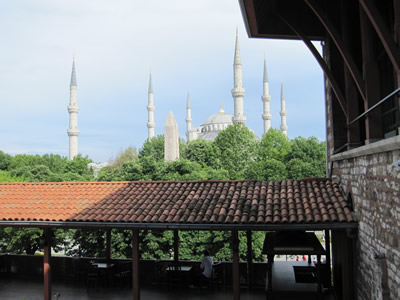 |
 |
||
| Nach unserem Besuch des Topkapi Palastes war die "Blaue Moschee" unser zweites Ziel, danach - Marschschritt, keine Müdigkeit vortäuschen - zum Sultanahmet Platz mit römischem Hippodrome, geklauten Obelisken und dem geschenkten Brunnen des 2. Willie. return to top | ||||
| Im linken Bild ist der Sultanamet Platz zu sehen mit den Ueberresten des römische Hippodrome - hier wurden in römischen Zeiten Wagenrennen abgehalten. Der Platz ist unter anderem geschmückt mit den etwas geflckten Resten des sogenannten "gemauerten Obelisken" der früher mit gehämmerten Kupferplatten verziert war die aber dann bei irgeneinem Krieg oder Aufruhr gestohlen wurden (zweites Bild von rechts) und dem besser erhaltenen Obelisk des Thutmosis (Bild rechts). Auf dem Platz befindet sich auch ein Brunnen gestiftet von Kaiser Wilhelm II - zweites Bild von links. | ||||
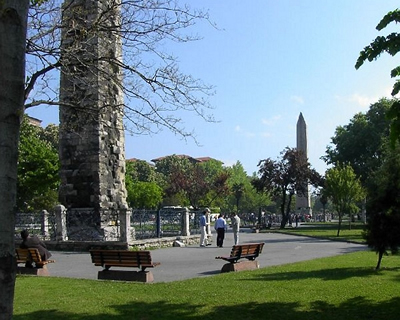 |
 |
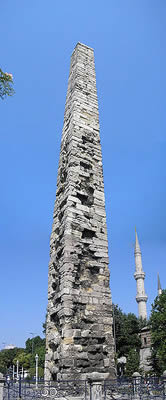 |
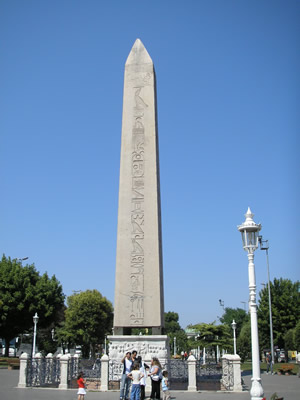 |
|
| But the main attraction here was Turkish-Islamic Art Museum | ||||
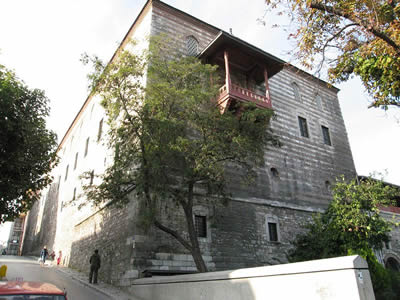 |
Or, to be honest, its cafe with a very nice strong cup of turkish coffee. Only after one (actually, I probably could have used two) I felt strong enough to wander through the museum. The building itself started life as the mansion of a former turkish pasha, but during its lifetime it has had many uses, until fairly recently it was decided to house variety of turkish artifacts here, prominent among them the extensive collection of very old rugs that at one time had done duty as prayer rugs. |  return to top return to top |
||
| At first I was puzzled by the fragmentary nature of the exhibits, until I realized that they had in parts been worn down by centuries of devoted muslim knees! The sample in the picture above was carefully chosen, I am sure, to show an intact piece. Equally interesting as the rugs were, in my opinion, a series of carefully constructed examples of the historical development of human habitation in Turkey from nomads living in portable yurts to the Istanbul elite living room of the 19th century showing off its the expensive European imports. | ||||
| The Bosporous | ||||
Finally the evening concluded with an excellent dinner somewhere in Istanbul where we also had a beautiful view of the Bosporous and the Asian side of Istanbul - see above. By the time we reached our hotel it was past 10 pm and even with jet lag I had no difficulty falling asleep! |
Our day continued with a lovely boat trip on the Bosporous, the strait that not only divides Europe from Asia but also divides modern Istanbul. The map below and the satellite picture on the right show how the Black Sea is connected through the narrow bosporous with the Sea of Marmara which, in turn is connected through the Dardanelles straits to the Aegeian Sea and thus to the Mediterranean Sea. |
A satelite picture of the Bosporous strait - at the top is the Black Sea, then the Bosporous and Istanbul, at the bottom the Sea of Marmara |
||
| return to top | ||||


